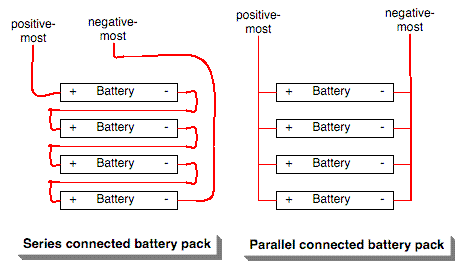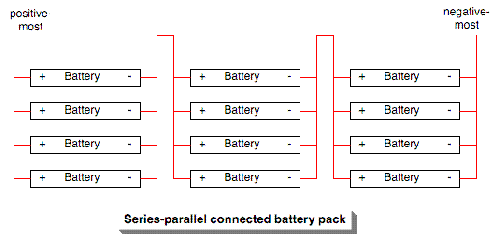Electrical Basics covering batteries in electric vehicles

The next electrical measurement of interest is "kilowatt-hours".
1 kilowatt-hour = 1 kilowatt used over 1 hour
1 kilowatt = 1,000 watts
To bring this to every day terms, the typical lightbulb is 100 watts, yes? Well, unless you're like me and use compact flourescent lighting, in which case the lightbulb in question uses about 40 watts. In any case, if you have ten 100 watt lightbulbs, that is 1,000 watts. Leave them running for an hour, and that is a kilowatt-hour. By modern electricity rates it will cost you in the neighborhood of ten cents for that electricity. As an electric vehicle moves down the road, it consumes electricity. Say the vehicle has a 120 volt electrical system, and uses 30 amps to cruise, therefore the vehicle cruises at 3.6 kilowatts. If the vehicle is run for an hour, it consumes 3.6 kilowatt hours of electricity.
Batteries are rated in voltage and amp-hour storage capacity. Obviously this is the kilowatt-hours of storage capacity. By the way, these measures also relate to batteries in cell phones and laptop computers, and directly relate to the "talk time" capacity of either one. In actuality the true capacity of a battery pack relates to the usage model.
When a battery company gives an "amp-hour" rating for a battery, they also specify the rate of discharge. Often the rating is given for a "20-hour" discharge, meaning that the rate amps are drawn from the battery is geared towards discharging the battery in a 20-hour period. When batteries are used at a higher rate the actual amp-hours that can be drawn from the battery often is lower than its 20-hour discharge rate implies.
<< Need a chart here showing the typical pattern - also explain C/20 and C/1 nomenclature >>
Wiring a battery pack for a given voltage and amperage
Since the typical batteries are 12 volts, how do we get a 120 volt (or more) battery pack? It's simply done by wiring the batteries in parallel or serial fashion to get the desired numbers.

In a series-connected battery pack the measurements come out as follows:
voltage = volts-per-cell * number-of-cells
amperage = amps-per-cell
In other words, for a series connected pack the voltages add based on the number of cells. However the amperage does not increase.
There is a big assumption in those formulas. Namely, that your battery pack will only use batteries of the same rating. Such a "matched" battery pack is known to work much better than a mis-matched battery pack. It's even best to measure the actual batteries and ensure that their actual characteristics match the other batteries in a given battery pack.
In a parallel-connected battery pack the measurements are the reverse of the series-connected ones:
voltage = volts-per-cell
amperage = amps-per-cell * number-of-cells
You can also combine techniques if necessary, to create a series-parallel battery pack

You can wire a series-parallel pack as shown (wire the batteries in parallel "strings", and connect each string in series) or the other way around (wire them in series strings, connecting each string in parallel). The effect will be the same, namely:
voltage = volts-per-string * number-of-strings
amps = amps-per-string * number-of-strings
Who's online
There are currently 0 users online.
Who's new
- eric01
- Norberto
- sarim
- Edd
- OlaOst


